
The Depot, Richmond
For almost a century, the Depot plays a significant part in every soldier’s life, be it as a new recruit, a member of the training or stores staff, or as somewhere to return between deployments or meet old friends. Occupying a commanding position overlooking the town, at the top of ‘Barrack Hill’ the Depot quickly becomes a key landmark, and part of the fabric of Richmond life.
A regiment’s home base for recruiting and training, the Depot is also where soldiers and officers waiting to leave the army or for new postings are based and where injured soldiers return after discharge from hospital. A variety of regimental stores, including kit and ammunition, are also kept there.
THE ROLE OF A REGIMENTAL DEPOT
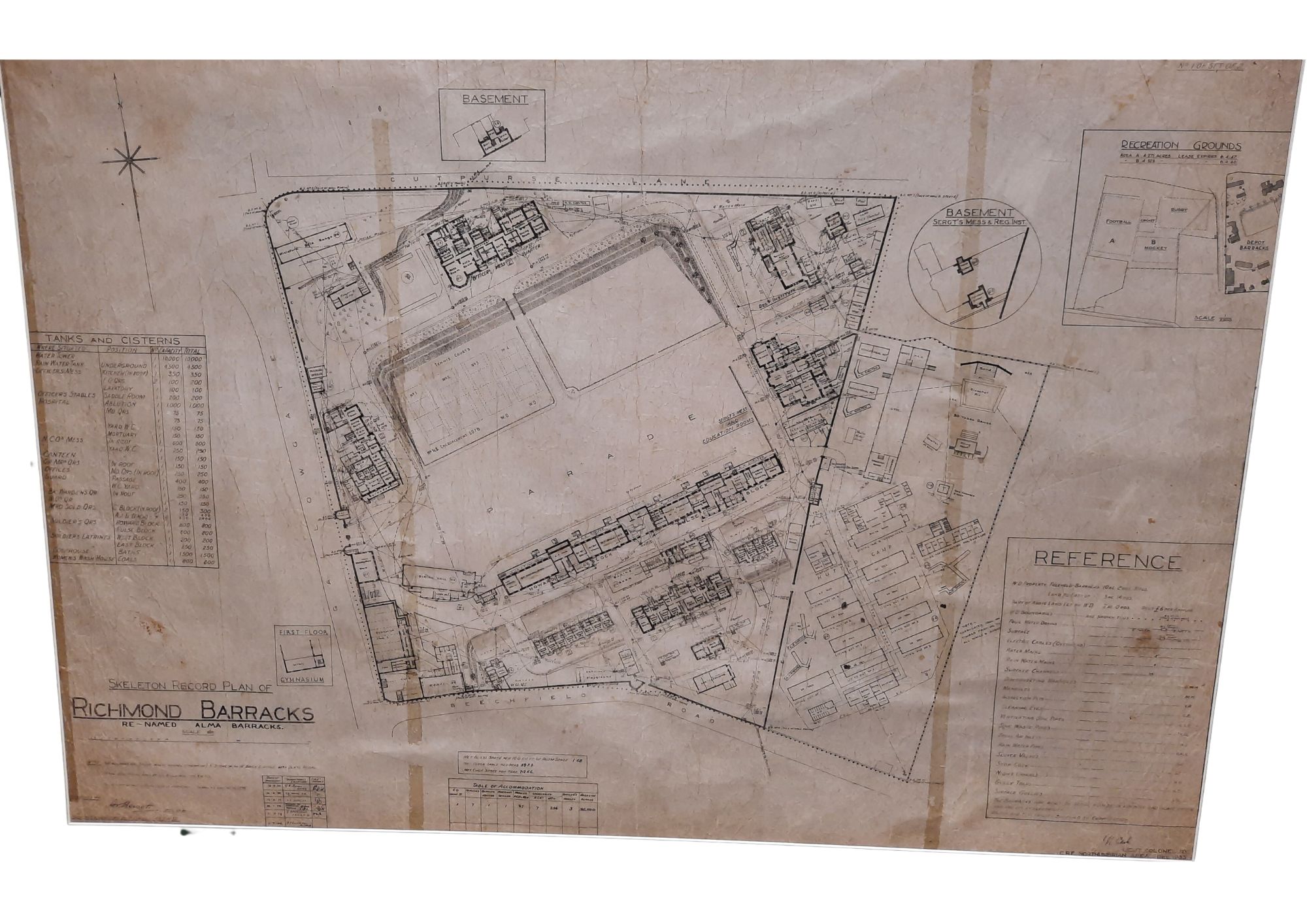
This plan of Richmond Barracks (re-named Alma Barracks, and known as the Depot) was originally created in 1933, undergoing several amendments between then and 1944, the most obvious showing the ‘hutted camp’, outside of the stone wall perimeter, created in the late 1930s.
As well as detailing the numbers of ‘tanks and cisterns’ and their locations, the plan includes a table of accommodation which lists provision for almost 300 officers and married and single soldiers, three officers’ horses and 360,000 rounds of ammunition.
It will be comforting news to many concerned that eight new quarters for married people, and a separate house for the Sergeant-Major, are in course of construction at the Depot. They are close to, and in line with, the existing married quarters and will be ready for occupation in six months. Each quarter is to contain four rooms, and that for the Sergeant-Major six.
The Green Howards Gazette, April 1893
Garden Village: Footprint of a Depot
Survey and Cartography by Phill Batts using OCAD software. Based upon the Ordnance Survey mapping with the permission of the Controller of Her Majesty’s Stationery Office. © Crown Copyright. License No 100015287. Map Copyright GVMC Ltd. Artwork Copyright Belfry Consulting.
“You were right when you said the barricks were up on top of hills. I thought we were never going to get there…The air is good down here, we can’t see any pit smoke, all blue sky if it is not raining…Richmond is a very old fashioned place, we were down there the other night but saw very little.”
18482 Private William Elliott, writing to his father from Richmond Barracks, as the Depot was then known. His letter is not dated, but we believe Private Elliott wrote it in late 1914.
Shortly after noon on Saturday, July 8th, the heaviest thunder and hailstorm ever experienced broke over Richmond. The hailstones, of phenomenal size, did great damage, over 20,000 panes of glass being smashed; and the town presented the appearance of having been bombarded. 500 panes were broken in the Barracks alone.
The Green Howards Gazette, August 1893

20 year old Madge Moore is working as a ‘domestic servant’ at the outbreak of the Second World War. She serves with The Green Howards E Company of the Auxiliary Territorial Service (ATS) at the Depot between October 1940 and May 1945, reaching the rank of Sergeant. She sends this photograph ‘to Evelyn from Madge XXOO’ in 1943.

The note on the back of this image says, ‘Hellings, my servant for 14 years and is with me still – went through the war with me from beginning to end.” The photo of Quartermaster Edward Pickard with Hellings was taken at the Depot.

Sergeant Frederick Woodall, pictured here in 1939, serves with the 4th Battalion at the Depot. He later becomes Mayor of Richmond in 1955/56 and 1962/3.

HM King George VI inspects the Home Guard at the Depot on 28 August 1940. The Robert ‘Mouseman’ Thompson chairs on which he and Queen Elizabeth sit to take tea during their visit are later engraved to mark the occasion. They are still in use in the museum’s Normanby Room.

The physical training team exercising on the grass at the Depot, 1943. This grassed area, marked out for tennis courts was in front of the Officer’s Mess building.

Thomas Halmkan is one of the best-known men in the regiment. He joins in 1906, serving for almost 39 years. Between 1908 and 1926 he sees continuous overseas service. He becomes Quartermaster at the Depot in 1938. Far from being an easy last job into retirement, Halmkan is responsible for kitting out thousands of the regiment’s Second World War soldiers. Thomas’s medals are in the museum collection. Find out more here.

This aerial image showing the Depot's two separate barrack blocks and surrounding open countryside was used on a regimental Christmas card.
National Service at the Depot
Between 1947 and 1960, thousands of soldiers arrive at Richmond for National Service, spending their first few weeks of army life at the Depot. During their army careers, many will return, perhaps passing through between deployments, finding roles in the structure of training the next new batch of Green Howards soldiers, or at the many veterans’ reunions which take place there.
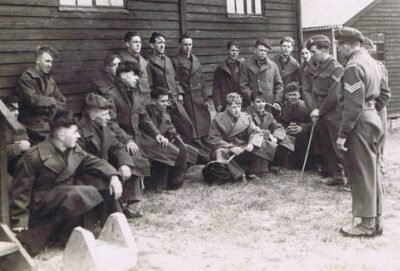
24 April 1947. Sergeant Ratcliffe and Coproral Doddgley address new recruits on their first day in the army, presumably before their visit to the on-site barber.
They are lined up against the ‘spiders’ – wooden huts which had been built in the late 1930s to accommodate the additional influx of troops at the Depot in the build up to the Second World War.
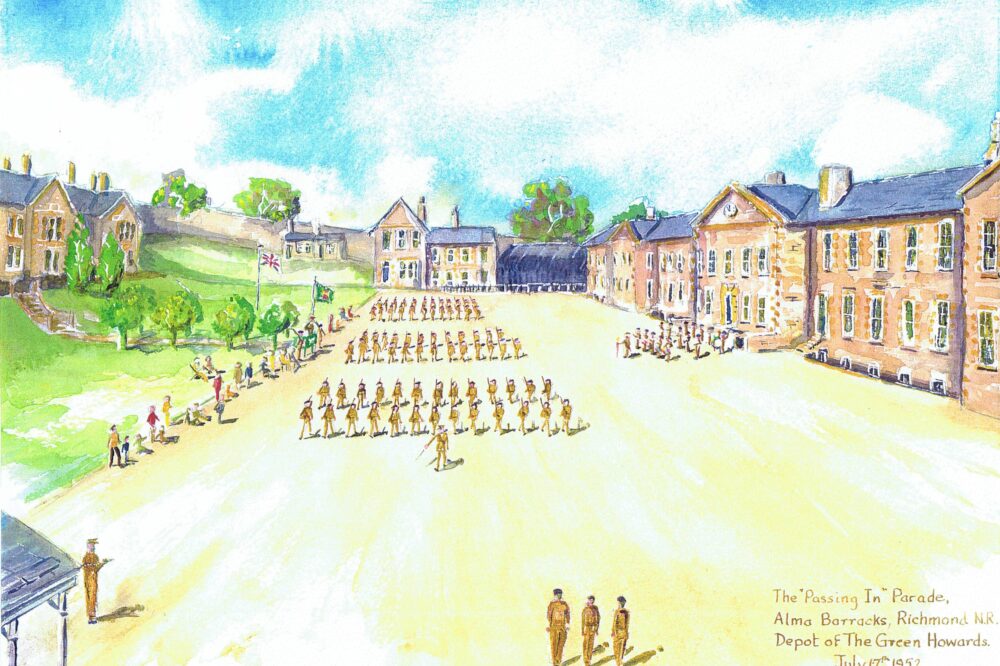
Peter Etherington spent the first six weeks of his National Service at the Depot in the summer of 1952. He painted this watercolour in about 2007. It depicts the parade which took place at the end of his training. Peter, from Teesside, has vivid memories of his time as a new National Serviceman in Richmond. Read about them here.

The Depot’s guardroom features as the backdrop to this press photo featuring twins George and John Walker arriving for training. The article in The Daily Express, 29 March 1956 reports:
Regimental Sergeant-Major George Calvert looked confidently at 17-year-old twins George and John Walker yesterday. Then he boomed: “We’ll soon sort ‘em out. You can tell a soldier by the way he marches and wears his uniform. And a man takes on characteristics of his own in uniform.”
How loyally they were supported by their young wives who lived in the horrible little quarters down the bank behind the barrack block.
They darned the soldiers’ socks, sewed tags on their shirts in preparation for the passing out kit inspection and all the 101 things a young Corporal wanted to have well done amongst his section.
Depot Commanding Officer between 1956 and 1958, Jock Neighbour, pays tribute to the Depot's army wives.

Major ‘Jock’ Neighbour (standing on the right) was in charge of the Depot when the Green Howards received the Freedom of Richmond. Soldiers marched from the Depot down the hill into the town, drums beating, Colours flying and bayonets fixed to receive the honour on 22 May 1958. Neighbour joined the regiment in July 1939. In the early 1980s, he recorded his memories of his time at the Depot for the museum’s archive.
You can listen to some of them here.

Tough act to follow. Troops at a passing out parade in 1960 are inspected by William McNally. A serious-looking Mc Nally, who served with the regiment during the First World War, wears his medals pinned to his suit jacket.
They include his Victoria Cross, awarded in October 1918 for his actions to disable and capture an enemy machine gun at the Piave River in Italy. McNally’s medals are now on display in the museum.

National Service, the army’s system of peacetime conscription, began in 1947 and lasted until 1960.
Call up papers like this one issued to Fred Westwater in 1952 were sent to young men throughout the country. They were told to notify their employer that they had been enlisted, provided with an advance of service pay and a travel warrant, and ordered where to report.
This Enlistment Order was issued on 29 April. Fred was to report to the Depot on 15 May.

Sport, for fitness, and for leisure (particularly in the case of Officers) formed a significant part of life at the Depot. This leather cricket ball features a silver shield marking the Ladies v Gentlemen fixture at The Barracks, Richmond, 19 August 1892.

This Depot Court Martial book contains details of the crimes and punishments of soldiers based there between 1881 and 1904, including the case of William Parker for…
“Deserting Her Majesty’s Service, in that he at Richmond Yorks on the 25th June 1886, absented himself from the Depot Yorkshire Regt until the 11th June 1891 when he surrendered to the Civil Power at Albany St, Police Station London, dressed in plain clothes.”
Parker was sentenced to imprisonment with hard labour for 56 days, but the court “recommend the prisoner to mercy on the ground that his mental condition is weak.”

A silver cigarette box, its body and lid decorated with dragons. Presented by Lt Gladstone to Colonel Bruce and the officers of the Depot in 1905.
ROAD NAME NOD TO HEROES
When the Depot site was redeveloped for residential use in 1985, its roads were named after four of the regiment’s 18 Victoria Cross recipients. They are Lyons Road, Atkinson Avenue, Dresser Close and Seagrim Crescent.

Private John Lyons (1855)
For conspicuous gallantry in the trenches before Sevastopol on 10th June, 1855. When a live shell fell in his traverse, he ran forward picked it up and threw it out thus saving the lives of many of his comrades.
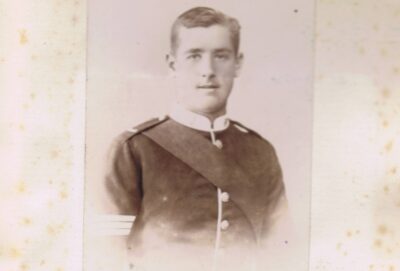
Sergeant Alfred Atkinson (1900)
During the Battle of Paardeberg on the 18th February, 1900, Sergeant Atkinson went out seven times under heavy and close fire to obtain water for the wounded. At the seventh attempt he was wounded in the head and died a few days afterwards.
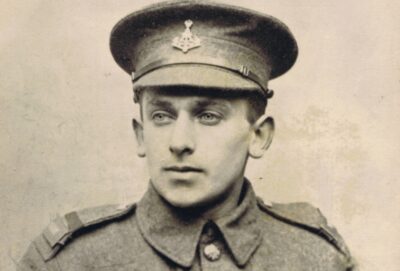
Private Tom Dresser (1917)
Private Dresser, in spite of being twice wounded on the way, and suffering great pain, succeeded in conveying an important message from battalion headquarters to the front line of trenches, near Roeux on 12 May, 1917, which he eventually reached in an exhausted condition. His fearlessness and determination to deliver this message at any cost proved of the greatest value to his battalion at a critical period.

Lieutenant Colonel Derek Seagrim (1943)
Derek Seagrim (right) was one of five brothers, all of whom served in the Second World War. In March 1943 he was in charge of trying to capture an important, heavily defended feature on the left flank of the main attack on the Mareth Line in Tunisia. His disregard for personal safety and outstanding example displayed over an intense two days of action ensured the taking and holding of the objective. He died of wounds received at the Battle of Akarit, 7 April 1943.
The Visitor Book 1901-1960
This online exhibition is just one strand of the work we do to bring our collection to you, wherever you may be. Use the boxes below to sign up for occasional museum news direct to your inbox, and make a donation to help support our work.
